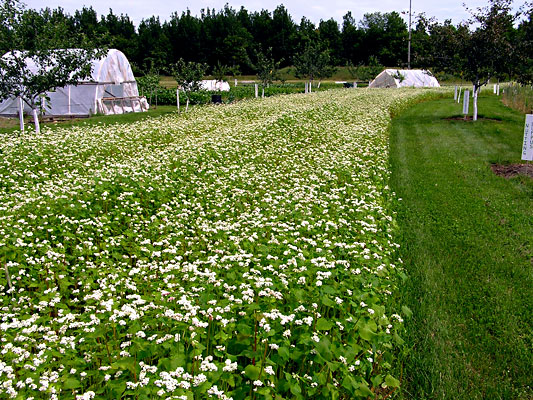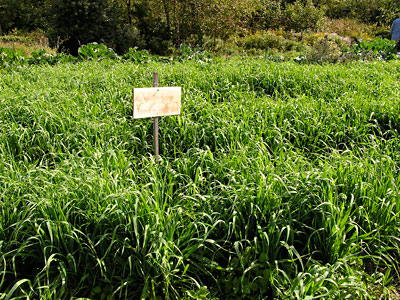 |
| A strip of buckwheat growing at MOFGA’s Common Ground Education Center. English photo. |
By Will Bonsall
The terms “green manure,” “cover crop,” “soiling crop” and “catch crop” are often used interchangeably, which is not quite accurate, but for this article I’m lumping them all together. I refer to any crop that is planted not for food but to protect the soil from erosion or drying out, to add fertility and organic structure to the soil, to smother weeds, and sometimes for special purposes such as making soil minerals such as phosphorus more available to following crops.
The obvious gain from a cover crop is the massive creation of humus-building material, seemingly out of nothing. That is, the main component elements of organic matter – H, C, O and N – are in the very air, infinitely replaceable, ready to be sequestered by the living community of the soil. The mineral part, the wee bit that comes directly from the soil itself, is not so easily replaced, especially if it is sent off to the marketplace in the form of produce. It may have to be imported from off-site in the form of mined concentrates; or perhaps not – that will be the topic of a future article.
Farmers use green manures more widely than do gardeners; however the latter have just as much to gain from these crops, although on a smaller scale. I suppose most gardeners figure they haven’t room for a non-food crop, especially when they can easily and cheaply import fertility, such as cow manure, from off-site. However, imported fertility is unlikely to supply the quantity or quality of humus-building material needed to really maintain soil structure, or tilth. Green manures do that quite handily if you can spare a little space. If you cannot, I urge you to find some way to expand your garden area to allow that. (Maybe dig up the rest of the lawn and play croquet on the sidewalk – priorities!) Just as it is important to rotate your vegetable crops so that, for example, you’re not planting cabbage where related crops grew last year, it is no less desirable to rotate vegetables out of that plot altogether, letting annual grasses and legumes give the soil a much-deserved break. Aside for protecting the soil and creating fertility, cover crops will reduce weed, pest and disease problems.
Also, do not assume that a soil-building crop necessarily means having a piece of land out of production for a whole season. A “catch-crop” can easily occupy just that area where your tomatoes are going to go – an area that is empty until late May; or again where early peas have come out in August. Those little spaces have too much potential to be left to the weeds.
That being said, remember that all green manure crops are not equal; each is suitable for particular times and situations and must dovetail with the gardener’s other needs to give maximum benefit.
Buckwheat is one of the most commonly planted cover crops, often for good reason, but sometimes not. When you have very sterile soil, poor in available minerals and organic matter, buckwheat is hard to beat – it requires very little investment for what it returns. And when you have a lot of aggressive and persistent weeds, such as witchgrass (aka quackgrass, Elymus repens), buckwheat is also a good choice, because it avidly grabs up available water and minerals such as phosphorus and starves out it neighbors. Furthermore, its many horizontal leaves shade out the competition. In fact, don’t try to companion buckwheat with other crops; it doesn’t play well with others.
On the other hand, when you have a modicum of tilth and want to ratchet it up higher, buckwheat isn’t necessarily the best choice. All of that lush mass consists largely of hollow watery stems and is not as dense as it appears. There are better choices, as I’ll get to shortly.
Moreover, since buckwheat is very cold-tender, it is useful only for that season when frost is not a concern. Better choices exist for the early and late seasons. Nevertheless, buckwheat is very fast growing and can make two or more heavy crops within those warm months. It’s a very useful plant for the right conditions.
 |
| Oats growing at the Troy Howard Middle School in Belfast. English photo. |
Given somewhat better soil, Japanese millet is a bodacious maker of biomass; however it too is very frost-tender. Moreover, I prefer to use cover crops for which I can produce my own seed (whether I necessarily do or not), and Japanese millet requires a longer, warmer season than I can count on.
My all-around favorite for most conditions is common oats (not the hull-less type I grow for eating). Oats are very cold-hardy, so I can sow them as soon as the snow goes or a few weeks before it returns, or any time in between. They grow quickly, and I can get at least three crops a year, turning each under just before it runs to seed. If it grows too tall and rank to handle with the rototiller, I may scythe the bulk of it for compost, but of course that leaves less biomass to be incorporated into the soil – my original intention. That still represents a huge net gain, however, as the stubble and root mass are much more valuable than they appear.
At my wife’s urging, I’ve sometimes planted oats as late as mid-October, not expecting much growth from such a late seeding. She is vindicated even if I get only 6 inches of growth: The biomass may not be impressive, but there are great benefits from having the soil protected by a covering of litter as it goes into winter. The thing is, oats will stand plenty of frost, but they won’t survive winter. Come spring I have a lot of dead debris to turn in, already well on its way to becoming humus. That is, in my opinion, its main advantage over winter rye and wheat: Those two crops go dormant over winter and in spring quickly form a dense mat that must be turned under before it becomes unmanageable. That may be fine if the ensuing crop is something that doesn’t get planted until Memorial Day, such as tomatoes or squash. Even then the rye must have been turned under a few weeks earlier or it will release chemicals that repress the main crop. Early-sown crops such as lettuce or carrots will suffer badly from the decaying rye, whereas last fall’s oat residue would cease to have been an issue.
Although I say “oats” and write “oats” on my garden maps, I really mean “oats and field peas” and sometimes “rape” as well. I have also used “minor” favas such as Bell beans, which work, although I usually plant those for human food (such as burgers, falafel, etc.). Rape is often a problem as it attracts flea beetles, but in this combination it seems much less affected. The mainstay of all these mixes is oats.
Any kind of feed oats will do well enough, but for cover-cropping, the oats grown for feed are not the best. They are bred for SEED yield, which is great for the producer and the horse feeder, but for cover-cropping the best sorts are the massive leafy types known as “hay oats.” My current favorite variety is ‘Sir Douglas Haig’ (a WWI general; don’t get me going about him), which is not available commercially. I’m trying to increase my own stock of that variety, as well as several others, to be able to offer them to others. Meanwhile perhaps you can convince your seed company to carry a hay oat or, better yet, perhaps you can grow your own seed.
Green manures aren’t always grasses or legumes: Some folks plant mustard, the residues of which can eradicate a lot of fungal soil diseases.
My longer-term green manure rotations usually contain perennial grasses (such as timothy) and perennial legumes (such as clover). Some of the plants we usually curse as weeds can give great service by delving down and bringing up minerals from the subsoil, minerals that would otherwise be inaccessible to our shallow-rooted crop plants. Yellow dock, dandelion and chicory are good examples of this, and I often deliberately sow them in rotation mixes to complement the others. (I don’t buy them; I just collect my own seed before mowing.) Since I scythe the green manure at least twice, usually thrice, in the season, they don’t get to make seed and become a nuisance. Sweet clover and alfalfa have the double advantage of fixing nitrogen while their deep taproots delve down for hidden minerals and break up hardpan.
Seed catalogs offer a number of other cover crop choices – check them out, but keep in mind the requirements of your particular conditions. By planting not only food crops but also “food for your crops,” you can make a much more organic environment where everyone, including you, is happier and healthier.
About the author: Will Bonsall lives in Industry, Maine, where he directs Scatterseed Project, a seed-saving enterprise. He is the author of “Will Bonsall’s Essential Guide to Radical Self-Reliant Gardening” (Chelsea Green, 2015) and he will be the keynote speaker at the Common Ground Country Fair on Sunday, Sept. 27. You can contact Will at [email protected].
